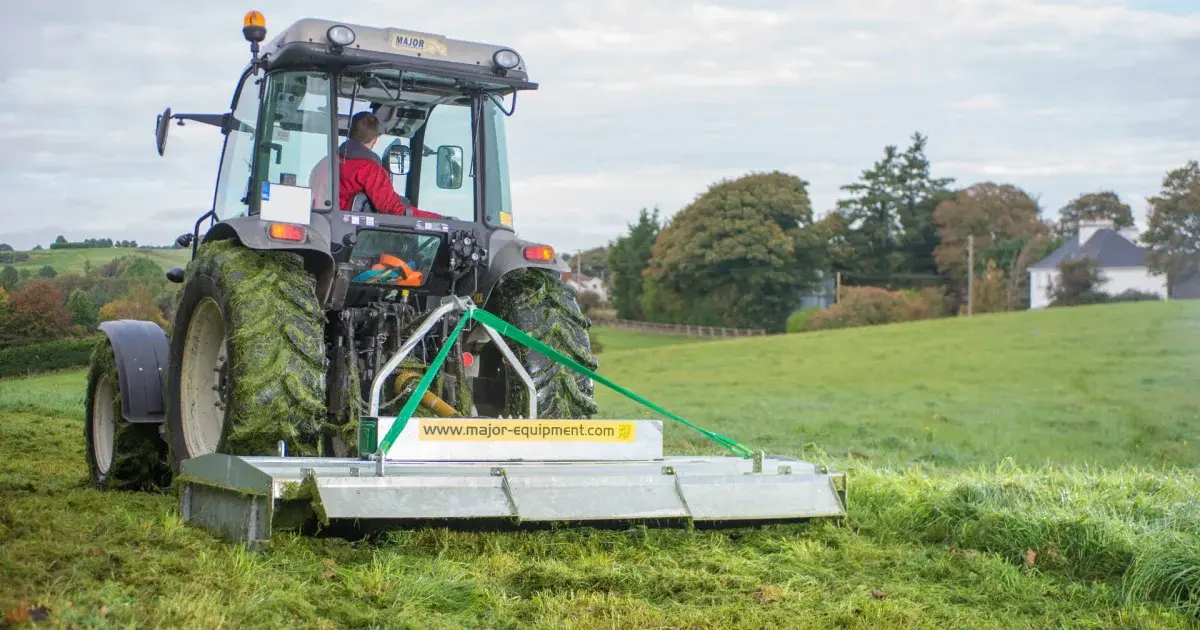10 simple methods for Vegetation Control
Vegetation control is all about the removal and reduction of overgrowth. There are a range of ...
Read more
Correct vegetation management brings various benefits to your farm. By topping your paddocks before introducing cattle for grazing, you can dramatically improve the quality and health of the grass.
In this article, we explain the importance of topping your paddocks and the best equipment for the job. We also share advice on when to top your paddocks in the grazing cycle to maximise your returns.
Topping your pasture is when you cut the top portion of grass growth, particularly the part consisting of seed heads. By redirecting the plant’s energy to the grass itself, this encourages faster growth and increases the nutritional quality of your pasture.
Topping also cleans your pasture of weeds and unwanted grass species, particularly in mid-spring and early summer. The pasture grows abundantly during these months so you can lower the mower and remove any undesirable stalky growth.
Many benefits come with topping your paddocks, whether you complete it yourself or hire one of your local vegetation management companies. The key advantages are laid out below.
By topping your pasture with a mower, the growth rates of your grazing paddocks will improve. This makes your grazing rotation more efficient and achieves a higher potential stocking rate.
A topper mower can mulch and top many of the weeds in your pasture, allowing the grass to grow instead. Meanwhile, the weeds are consumed by your livestock.
Grazing your paddocks too much will lead to low growth levels and diminish your returns. Fortunately, topping your paddocks immediately before introducing livestock can stop them from grazing too hard. For more advice on assessing and managing your pastures, check out the Feedsmart Feed Sheep and Cattle Smarter Resource Book.
After every rotation, you’ll notice there is always some grass left uneaten. A topper mower allows you to clear these clumps and promote new growth at a consistent rate across the whole paddock.
Fresh and nutritious grass has a significant impact on your cow’s milk production. Topping your paddocks before grazing could even encourage the herd to eat higher volumes of unselected pasture, increasing their fibre, energy, and protein intakes. After all, happy and healthy cows are proven to produce more milk.
In New Zealand, the best time to top your paddocks is October through to January, either immediately before or after a grazing rotation. During this time, the warmer temperatures and high moisture content lead to higher growth rates. From late summer to early spring, your pasture is best left alone.
After your cattle have grazed a paddock, topping allows you to remove any stems or stalks. However, compared to topping your paddock before grazing, this is relatively messy and may result in lower pasture utilisation. Instead, we recommend topping your paddocks before introducing cattle for another rotation.
When topping your paddocks, the following steps will ensure you achieve the best results.
The first step in pasture topping is choosing the right machinery, depending on your needs. Many farmers use a standard hay or silage mower because they already have one. This option is best used immediately before grazing because the topped grass will wilt and become more appealing to livestock.
A rotary slasher-type mower is suitable for topping paddocks immediately after grazing, particularly when only unpalatable grass is left over. It will slash the pasture into a mulch-like consistency and simply integrate into the soil matter. This also spreads the cut grass like compost, fertilising the soil evenly.
For advice on the best topping machine for your farm, ask our team or explore more details below.
It is common for clumps of various species to form, including cocksfoot, thistle, and rushes. These need to be mown down to allow the highly nutritious grass to grow through instead. It is best to get rid of these clumps before the topping season begins.
Another critical tip is to ensure you always have sharp high-rev blades because you need to make a clean cut. Using dull blades may damage the pasture, tugging grasses out of the soil instead of cutting properly. This weakens the root system and impacts growth.
Whatever machine you choose to use, always set the blades low. Most grasses should be topped down to 80mm, removing the seed head and enabling the plant to redirect its efforts into leaf production instead.
To ensure your pastures can recover quickly, don't mow more than one-third of the grass’ height at a time. For example, if your pasture is approximately 120mm high, mow it at 80mm. If the grass is still too high after one mow, wait two or three days before mowing again.
At AgriQuip, we specialise in tractor attachments and agricultural equipment from reputable brands. In our range of vegetation management attachments, we supply the following topper mowers.
These rotary mowers feature an extremely durable steel deck construction, a heavy-duty 250 HP input gearbox, and 8 pneumatic rear wheels with puncture-resistant industrial tyres.



Discover more about Spearhead Multicut Rotary Mowers ›
These three-point linkage machines are designed to fold up during transport. They are also finished with a hot dip galvanised finish and the contra-rotating swinging blades are retained in hardened steel bushings and clamped by sprung steel blade backs.
%201%20(1).webp?width=1200&height=642&name=Major%20MJ38-540%20Flex%20Wing%20Topper%20(44)%201%20(1).webp)
Discover more about MAJOR Flex Wing Toppers ›
The Centre Mounted Topper is a low-maintenance mower with high-speed rotors and twin-cut swinging blades. These machines are ideal for topping paddocks, featuring extra heavy-duty gearboxes and a solid frame.


Vegetation control is all about the removal and reduction of overgrowth. There are a range of ...
Read more.jpg?width=352&name=Farm%20tools%20and%20equipment%20(3).jpg)
Budget 2025 introduced the Investment Boost scheme on 22 May, allowing businesses to deduct 20% of ...
Read more
When running a farm, the expenses can seem never-ending. Fortunately, there are several ways to ...
Read moreStay updated with our blog and keep in the loop with new products and everything you need to know about Agriquip.